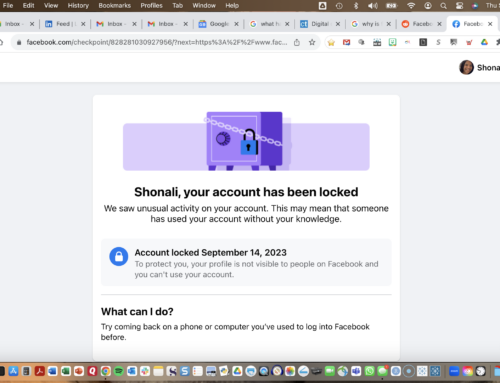 The big story last week was Invisible Children’s 30-minute film on Joseph Kony. I mean, you just couldn’t get away from it.
The big story last week was Invisible Children’s 30-minute film on Joseph Kony. I mean, you just couldn’t get away from it.
I was fascinated; not by the video so much (which I agree was beautifully produced), but by the amount of conversation it generated. So I talked to a few of my colleagues in the nonprofit world, all powerhouse professionals, to get their take on a couple of things.
And while much has already been written about the campaign, including this terrific Forbes piece on social media lessons, here are a few things nonprofit organizations should keep in mind when using digital media to further their causes:
1. You must let the truth get in the way of a good story
One of the primary criticisms is that the Kony 2012 video doesn’t accurately represent the current state of affairs in Uganda and the LRA, not to mention the fact that Kony hasn’t been in that country in a while. Invisible Children (IC) said that in order for the story to resonate, they had to simplify it, and basically admitted via the statement on their site that they left out a lot of detail:
“In our quest to garner wide public support of nuanced policy, Invisible Children has sought to explain the conflict in an easily understandable format, focusing on the core attributes of LRA leadership that infringe upon the most basic of human rights. In a 30-minute film, however, many nuances of the 26-year conflict are admittedly lost or overlooked.”
Yes, the story is complicated. But with the expert videographic talent at their disposal, I have a hard time believing IC couldn’t have given a sense of history by date-stamping the different interviews and so on.
Beth Kanter agreed, saying, “I believe nonprofits in a day of social media connectedness, really have to understand transparency and that they can’t get away with not being transparent.” Beth elaborated further on this in a recent post, reiterating that “for responsible social change, you need transparency.”
2. How much story-telling is “too much” story-telling?
Kami Watson Huyse raised an interesting point. She said, “It was clear to me that this video was a story-telling exercise, and stories, by definition are personal and take a particular point of view. I was more concerned with his use of his own son’s reaction as part of the story.
“The truth is a matter of interpretation. I think that this video was designed to get people to act, not to be a realistic documentary.”
While I’m not a parent, I would imagine this would resonate with many of you who are. We’ve seen time and time again that good stories are those are easy to understand and that pull on your heartstrings. But do you really have to bring your kids into it?
From Beth on story-telling: “Successful messaging is compelling, visual, emotional, and simple. Some highly effective online activists told me that one of their secrets is that their messaging is at 6th-grade level because that makes it clear and simple to understand. That’s a good thing to do.”
Kony 2012 did that in spades. But at what price? At what point does the story take over the agenda… or become the agenda? It goes back to being transparent – which pretty much everyone I asked agreed was key. Nancy Schwartz summed it up perfectly: “The end doesn’t justify the means.”
3. It’s tough to say “no” to kids
 I first heard about the video from my Hopkins students; granted, they’re not kids, but they’re exactly the demographic of young activist and activist-oriented people that the film was trying to reach. Beth said she first heard about it from her 6th-grade son. JD Lasica, my Socialbrite colleague, first heard about it from his 12-year old son (and by the way, interviewed one of the IC founders a few years ago).
I first heard about the video from my Hopkins students; granted, they’re not kids, but they’re exactly the demographic of young activist and activist-oriented people that the film was trying to reach. Beth said she first heard about it from her 6th-grade son. JD Lasica, my Socialbrite colleague, first heard about it from his 12-year old son (and by the way, interviewed one of the IC founders a few years ago).
My guess is that this scenario, or versions of it, was played out in countless homes across America last week.
What happens when your kids, or young people you are responsible for, announce a new fact? You go look it up. What happens when they tell you they’ve just learned about ____ cause and are going to support it? You go look it up… because you want to support them, you’re proud of their developing a social conscience, and you don’t want to let them down. Right?
And if they ask you to support it along with them, it becomes really, really hard to say “no,” especially if they are convinced that a particular cause is going to hunt down a “bad guy.” Because if you refuse, doesn’t that make you a bad guy by association?
If you’re going to try and generate social change through young people, you have a responsibility to them to make sure they understand exactly what they’re getting into. Yes, this goes back to telling the truth. Because if you don’t, it could backfire.
4. Be prepared for everything to be scrutinized
IC started out trying to raise awareness; in their own words, to “make Joseph Kony famous.” But now everything about the nonprofit is being scrutinized, from its financials to its motives. To its credit, IC has posted several years’ worth of 990s on its site and clearly reiterated, time and time again, the approximate breakdown of expenses.
Did it anticipate having to do this? Probably. But it probably didn’t anticipate the amount of criticism that would be leveled at it. In fact, yesterday CNN reported that director Jason “Russell said he had been a little surprised by some of the criticism. ‘I didn’t know there was that much tension,’ he said.”
Personally, I find this a little naïve. If you’re dealing with an issue that is emotional at its core, it’s going to create, or reveal, tension. The nonprofit world, while doing a lot of good, has its share of competition and politics; after all, there is only so much attention the rest of us have to direct towards causes, and there is only so much our pocketbooks can take. Of course there’s going to be tension.
So even if you don’t think your mission will generate controversy, prepare as if it will. Be prepared for everything – everything – to be scrutinized. And though your original message might be co-opted or broken down in ways you hadn’t anticipated, at least you will remain part of the conversation.
5. Be really clear on how you allocate funds and what you classify as direct services
One of the major criticisms that’s been made is that only about a third of the money Invisible Children raises goes to direct services, with the other (approximate) two-thirds going to film production and marketing. Russell has been unapologetic about this, basically saying that this is how they function, and that raising awareness (through videos, marketing, social media, etc.) is critical to their cause.
This is a conundrum that a lot of nonprofits have to face. Because without marketing, you can’t raise awareness; without awareness, you can’t get donations; without donations, you can’t fund your programs.
And since the percentage allocated to programs is one of factors in ratings issued by nonprofit evaluation sites like Charity Navigator (note it gives IC only two stars out of four for accountability and transparency), you have to be really careful that the public is given as accurate a picture as possible about not just how you raise money, but how you spend it and what exactly classifies as a “program.”
Should rating sites change the way they evaluate nonprofits, particularly to account for the increased importance of marketing? As Kami pointed out, this has been an ongoing debate for a while.
But one way that IC could do this is, as Nancy pointed out, to “consider Marketing as the program. If raising awareness is the goal, this stuff is the program!” (If you look at IC’s description of its programs, they all seem to be direct service-based.)
The 10 minutes that could have been avoided
Today Invisible Children is expected to release another video addressing some (I hope most!) of the criticisms that appeared last week. I’m going to watch it with interest…
… but I can’t help feel that if they’d only told the whole truth in the original video, as opposed to what just made for the best story, there might not have been a need for the second video.
What do you think about the Invisible Children video and ensuing firestorm? Do you have other lessons for nonprofit organizations, or do you think I got any of the above wrong? And many thanks to Beth, Nancy, JD and Kami for helping me put this post together!



![[EVENT]: PR Hacks for Small Biz (online)](https://shonaliburke.com/wp-content/uploads/2021/06/FB-Ad-1200x800-01-01-01-Copy-500x383.jpeg)





[…] 5 Lessons for Nonprofits from Kony 2012 (waxingunlyrical.com) […]
:)
:)
@mdbarber Belated thanks for sharing!
@rebeccaedgar Thanks so much for sharing.
@adamtoporek Thank you for sharing!
Great points Shonali. I think the stories are important but they just should be used to enhance the message not alter it.
@adamtoporek Exactly!
@dcify Thanks so much for the thoughtful comment and sharing as well!
@writeonnetwork You liked that line? Thank you!
[…] comes to the facts, there really isn’t any wiggle room. As PR pro Shonali Burke writes in her blog about the recent Kony 2012 controversy, “You must let the truth get in the way of a good […]
This post raises many excellent questions for nonprofits when creating marketing materials, but also for parents when we’re teaching our children to give back. There are so many heartbreaking stories out there it’s a shame when they are misused. I hope IC, and others, learn from this.
@mdbarber I remember you writing on your blog about how it’s so important for us to make wise and informed choices when we decide which causes to support. Of course, we should all do our research, but it definitely helps when the materials organizations create and distribute are accurate, doesn’t it?
@dcIfy Interesting. Did you see the Kristof blog piece? Halo effect, too? A higher profile for Kony makes our work @CongoSister easier.
@pledman It also vivifies tension btwn expediency & justice. For every way we draw attn we also re/create moral vwpts. Legitimate & real
Thanks Shonali. A really thoughtful post. I think one of the things you capture in your post is that “story-telling” is an inherently ethical activity. Personally, I’ve been quite excited by the increasing embrace (in our very Western culture) of the place and power of stories in our society as a basis for social knowledge. But your 5 points really drive home the idea that it’s important for us not just to understand that stories are powerful/persuasive but that persuasion is an inherently moral act; for which we’ll be scrutinized. Through stories/persuasion, we invite audiences to reflect on things (and judge themselves), make moral choices and to act out of those moral imperatives.
I too think (some of) Jason Russell’s comments reveal a bit of naiveté, but I’m also not surprised. It’s exciting to think about the good we can do by our campaigns, the communities we galvanize and the action we can induce. But for every way we build a team of action, we implicitly create/recreate boundaries that exclude other people & courses of action. An implication or lesson from IC’s Kony2012 film is that merely developing a story that grips people is insufficient for ethical activism.
Those of us who produce discourses, who strive to bring about social change through those messages, need to internalize that what we do, how, when, where and with whom we do this all have ethical dimensions. The response to IC’s Kony2012 is a reminder that public discourse is indeed public accountability. And what a vulnerable place to put oneself. To that extent, kudos to IC & Russell for taking that jump.
@dcIfy And what a thoughtful comment, Ify, thank you!
Isn’t it interesting how we tell stories? We want them to captivate, so often there is “poetic license” taken… but in cases like this, I think you’re absolutely right – story-telling must be ethical.
You are more forgiving towards Russell et al than I am. I do think there is a lot of passion there, but when you are a filmmaker, you are also consciously making choices every moment; what frames to use, how to edit, etc. I’ve never made films, but I do have a theater background, and it’s very much the same priciple, particularly when you workshop a piece; now you have all this great/thought-provoking content, but what is the audience going to react best to? And that’s what you keep. That’s what I think Russell and co. did here.
I’m not so sure IC realized it was making itself vulnerable by releasing this video. I think they thought it was so powerful, everyone would be blown away… and of course, they were, but then they started asking questions. So I feel there was a bit of arrogance here as well, good intentions notwithstanding.
I really liked the piece, and I think IC has done a great job of answering the criticisms. I think they even did a good job of addressing the Charity Navigator issue (and they have issues of their own and have come under fire numerous times in the past). I have been following and supporting them since pretty much at the beginning and know a number of people who work there.
I think the most compelling thing is the use of the story. It’s one thing to say “This problem is hurting x number of people” and another to put a real face on it. I think that is why this video got the plays that it did. I mean, it’s a half hour long! videos that long never get this kind of play or reaction.
I agree particularly with your 5th point, that the marketing IS a part of their program, so the numbers don’t truly reflect what is happening with the money.
I’m really interested in how this will play out, both here for IC and in Africa in terms of how people view Kony and others like him. For years the One Campaign was really shining a nice light on what was going on over there, and then we heard a lot about Darfur. Now we are again keeping a close eye on Africa again, and hopefully this will mean great change in a lot of ways, and a better life for a lot of people.
@KenMueller I think IC has certainly borne up very well under the criticisms. They’ve stayed on message and are amazing self-assured for people so young. But see, I don’t agree that the end – particularly when it comes to not teling the whole story – justifies the means. Yes, they did a beautiful job of making the story compelling but I really really do not like the way they glossed over the current state of affairs. They had 30 minutes, for goodness’ sake. Choices were made of what to show and not to show during each and every second of the video. I think the choice could have been made to tell the story accurately as well, and not their version of the truth, or what they want people to believe.
I don’t doubt they are sincere people. But to me, their brand is a little tarnished.
@zoeticamedia Thanks so much for sharing. @kamichat you too – you always have great insights.
My biggest concern with any of these organizations is how much money is actually going to the ’cause’. I know it takes people to run it and people have to get paid but sometimes I see these things take on a life of their own and people are more concerned about getting paid than providing the service.
I’m a volunteer Guardian ad Litem; these are kids who have fallen between the cracks and are in the ‘system’ through no fault of their own. The ‘system’ is a huge government machine that takes a lot of money to run it. Therefore, it’s a lot of money but never enough money for the kids. It frustrates me as a tax payer to see how much inefficiencies and redundancy I see; essentially a big waste of money. I see some non-profits get like this as well.
So many causes; how do you pick your ‘pet’ project?
@bdorman264 That is such a big concern for so many people, Bill. And that is one of the things I find really fascinating; if “raising awareness” itself is the mission of a nonprofit, then obviously much less/none is going to direct services (and I’m not saying that’s the case with IC, just making a supposition). But if a nonprofit that is so charged, does indeed raise awareness successfully (can you imagine the measurement of that?!), then can we really say they are not doing a good job?
I think your point about the “system” is a really good one. I don’t know the government agencies at play in your guardianship program, but my guess is that even the bureaucrats get frustrated by how much time and effort it takes to run. I’ve seen that with many civil servants, including my husband, and a lot of times folks forget that the government workers are people too (not saying that YOU imply that) with similar frustrations.
I’ve been thinking a lot about how I pick the charities I support; of course I try to help when friends ask me/us to support their causes, but honestly, it invariably comes down to women and animals. I suppose those are the two causes I feel most connected to. So the causes that connect closest to those two … er, areas?… are the ones I tend to support over the long haul.
Thanks for being first to stop by, Bill… and see you very soon!
@Shonali Hey, I like women and animals too…………….just sayin’………
@bdorman264 You make a good point about effectiveness Bill. You know, there is a helpful site called Charity Navigator that ranks charities based on the percent of funds that go to service versus admin (and some other metrics I think).